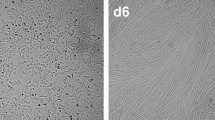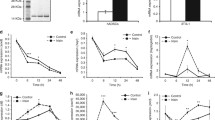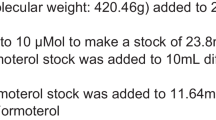Abstract
Exercise offers several benefits for health, including increased lean body mass and heightened energy expenditure, which may be partially attributable to secretory factors known as myokines. Irisin, a recently identified myokine, was shown to increase metabolic rate and mitochondrial content in both myocytes and adipocytes; however, the mechanism(s) of action still remain largely unexplained. This work investigated if irisin functions by acting as an inflammatory myokine leading to cellular stress and energy expenditure. C2C12 myotubes were treated with various concentrations of irisin, TNFα, or IL6 for various durations. Glycolytic and oxidative metabolism, as well as mitochondrial uncoupling, were quantified by measurement of acidification and oxygen consumption, respectively. Metabolic gene and protein expression were measured by quantitative real-time polymerase chain reaction (qRT-PCR) and immunoblotting, respectively. Mitochondrial content was assessed by fluorescent imaging. NFκB activity was assessed using an NFκB GFP-linked reporter system. Consistent with previous findings, irisin significantly increased expression of several genes including peroxisome proliferator-activated receptor γ coactivator-1α (PGC-1α) leading to increased mitochondrial content and oxygen consumption. Despite some similarities between TNFα and irisin treatment, irisin failed to activate the NFκB pathway like TNFα, suggesting that irisin may not act as an inflammatory signal. Irisin has several effects on myotube metabolism which appear to be dependent on substrate availability; however, the precise mechanism(s) by which irisin functions in skeletal muscle remain unclear. Our observations support the hypothesis that irisin does not function through inflammatory NFκB activation like other myokines (such as TNFα).




Similar content being viewed by others

References
Abd TT, Jacobson TA (2011) Statin-induced myopathy: a review and update. Expert Opin Drug Saf 10:373–387
Albrecht E, Norheim F, Thiede B, Holen T, Ohashi T, Schering L et al (2015) Irisin - a myth rather than an exercise-inducible myokine. Sci Rep 5:8889
Aydin S, Aydin S, Kuloglu T, Yilmaz M, Kalayci M, Sahin I et al (2013) Alterations of irisin concentrations in saliva and serum of obese and normal-weight subjects, before and after 45 min of a Turkish bath or running. Peptides 50:13–18
Aydin S, Kuloglu T, Aydin S, Kalayci M, Yilmaz M, Cakmak T et al (2014) A comprehensive immunohistochemical examination of the distribution of the fat-burning protein irisin in biological tissues. Peptides 61:130–136
Bhatnagar S, Panguluri SK, Gupta SK, Dahiya S, Lundy RF, Kumar A (2010) Tumor necrosis factor-a regulates distinct molecular pathways and gene networks in cultured skeletal muscle cells. PLoS One 5(10):e13262
Bostroem P, Wu J, Jedrychowski MP, Korde A, Ye L, Lo JC et al (2012) A PGC1-alpha-dependent myokine that drives brown-fat-like development of white fat and thermogenesis. Nature 481:463–U72
Castillo-Quan JI (2012) From white to brown fat through the PGC-1 alpha-dependent myokine irisin: implications for diabetes and obesity. Dis Model Mech 5:293–295
Daskalopoulou SS, Cooke AB, Gomez Y-H, Mutter AF, Filippaios A, Mesfum ET et al (2014) Plasma irisin levels progressively increase in response to increasing exercise workloads in young, healthy, active subjects. Eur J Endocrinol 171:343–352
Ellefsen S, Vikmoen O, Slettalokken G, Whist JE, Nygaard H, Hollan I et al (2014) Irisin and FNDC5: effects of 12-week strength training, and relations to muscle phenotype and body mass composition in untrained women. Eur J Appl Physiol 114:1875–1888
Erickson HP (2013) Irisin and FNDC5 in retrospect: an exercise hormone or a transmembrane receptor? Adipocytes 2:289–293
Evans MJ, Scarpulla RC (1990) NRF-1—a transactivtor of nuclear-encoded respiratory genes in animal-cells. Genes Dev 4(6):1023–1034
Gannon NP, Vaughan RA, Garcia-Smith R, Bisoffi M, Trujillo KA (2014) Effects of the exercise-inducible myokine irisin on malignant and non-malignant breast epithelial cell behavior in vitro. Int J Cancer 136(4):E197–E202
Giulivi C, Ross-Inta C, Horton AA, Luckhart S (2008) Metabolic pathways in anopheles stephensi mitochondria. Biochem J 415(2):309–316
Gleyzer N, Vercauteren K, Scarpulla RC (2005) Control of mitochondrial transcription specificity factors (TFB1M and TFB2M) by nuclear respiratory factors (NRF-1 and NRF-2) and PGC-1 family coactivators. Mol Cell Biol 25:1354–1366
Gouni-Berthold I, Berthold HK, Huh JY, Berman R, Spenrath N, Krone W et al (2013) Effects of lipid-lowering drugs on irisin in human subjects in vivo and in human skeletal muscle cells ex vivo (2013). PLoS One 8(9):e72858
Ho RC, Hirshman MF, Li YF, Cai DS, Farmer JR, Aschenbach WG et al (2005) Regulation of I kappa B kinase and NF-kappa B in contracting adult rat skeletal muscle. Am J Physiol Cell Physiol 289:C794–C801
Huh JY, Mougios V, Kabasakalis A, Fatouros I, Siopi A, Douroudos II et al (2014) Exercise-induced irisin secretion is independent of Age or fitness level and increased irisin may directly modulate muscle metabolism through AMPK activation. J Clin Endocrinol 99:E2154–E2161
Huh JY, Panagiotou G, Mougios V, Brinkoetter M, Vamvini MT, Schneider BE et al (2012) FNDC5 and irisin in humans: I. Predictors of circulating concentrations in serum and plasma and II. MRNA expression and circulating concentrations in response to weight loss and exercise. Metab Clin Exp 61:1725–1738
Kalinkovich A, Livshits G (2015) Sarcopenia—the search for emerging biomarkers. Ageing Res Rev 22:58–71
Kelly DP (2012) Irisin, light my fire. Science 336:42–43
Kelly M, Gauthier M-S, Saha AK, Ruderman NB (2009) Activation of AMP-activated protein kinase by interleukin-6 in rat skeletal muscle association with changes in cAMP, energy state, and endogenous fuel mobilization. Diabetes 58:1953–1960
Knutti D, Kaul A, Kralli A (2000) A tissue-specific coactivator of steroid receptors, identified in a functional genetic screen. Mol Cell Biol 20:2411–2422
Komolka K, Albrecht E, Schering L, Brenmoehl J, Hoeflich A, Maak S (2014) Locus characterization and gene expression of bovine FNDC5: is the myokine irisin relevant in cattle? PLoS One 9(1):e88060
Kramer HF, Goodyear LJ (2007) Exercise, MAPK, and NF-kappa B signaling in skeletal muscle. J Appl Physiol 103:388–395
Kunsch C, Rosen CA (1993) NF-kappa-B subunit-specific regulation of the interleukin-8 promoter. Mol Cell Biol 13:6137–6146
Kurdiova T, Balaz M, Vician M, Maderova D, Vlcek M, Valkovic L et al (2014) Effects of obesity, diabetes and exercise on Fndc5 gene expression and irisin release in human skeletal muscle and adipose tissue: in vivo and in vitro studies. J Physiol 592:1091–1107
Lecker SH, Zavin A, Cao P, Arena R, Allsup K, Daniels KM et al (2012) Expression of the irisin precursor FNDC5 in skeletal muscle correlates with aerobic exercise performance in patients with heart failure. Circ Heart Fail 5:812–818
Moreno-Navarrete JM, Ortega F, Serrano M, Guerra E, Pardo G, Tinahones F et al (2013) Irisin is expressed and produced by human muscle and adipose tissue in association with obesity and insulin resistance. J Clin Endocrinol 98:E769–E778
Park M, Kim D, Choi J, Heo Y, Park S (2015) New role of irisin in hepatocytes: the protective effect of hepatic steatosis in vitro. Cell Signal 27(9):1831–1839
Park KH, Zaichenko L, Brinkoetter M, Thakkar B, Sahin-Efe A, Joung KE et al (2013) Circulating irisin in relation to insulin resistance and the metabolic syndrome. J Clin Endocrinol 98:4899–4907
Pfaffl MW (2001) A new mathematical model for relative quantification in real-time RT-PCR. Nucleic Acids Res 29(9):e45
Polyzos S, Kountouras J, Shields K, Mantzoros C (2013) Irisin: a renaissance in metabolism? Metabolism 62:1037–1044
Polyzos S, Mantzoros C (2015) An update on the validity of irisin assays and the link between irisin and hepatic metabolism. Metabolism S0026–0495(15):00166–3
Pothineni NV, Ding Z, Mehta JL (2013) Is irisin an early marker of statin-induced myopathy? bench to the bedside. C Clin Lipidol 8:623–625
Puigserver P, Rhee J, Lin JD, Wu ZD, Yoon JC, Zhang CY et al (2001) Cytokine stimulation of energy expenditure through p38 MAP kinase activation of PPAR gamma coactivator-1. Mol Cell 8(5):971–982
Sathasivam S (2012) Statin induced myotoxicity. Eur J Intern Med 23:317–324
Sathasivam S, Lecky B (2008) Statin induced myopathy. BMJ 337:a2286
Scarpulla RC (2002) Transcriptional activators and coactivators in the nuclear control of mitochondrial function in mammalian cells. Gene 286(1):81–89
Scharhag-Rosenberger F, Meyer T, Wegmann M, Ruppenthal S, Kaestner L, Morsch A et al (2014) Irisin does not mediate resistance training-induced alterations in resting metabolic rate. Med Sci Sports Exerc 46:1736–1743
Scheler M, Irmler M, Lehr S, Hartwig S, Staiger H, Al-Hasani H et al (2013) Cytokine response of primary human myotubes in an in vitro exercise model. Am J Physiol Cell Physiol 305:C877–C886
Singh P, Kohr D, Kaps M, Blaes F (2010) Skeletal muscle cell MHC I expression: implications for stain-induced myopathy. Muscle Nerve 41:179–184
Timmons JA, Baar K, Davidsen PK, Atherton PJ (2012) Is irisin a human exercise gene? Nature 488:E9–E10
Vaughan RA, Gannon NP, Barberena MA, Garcia-Smith R, Bisoffi M, Mermier CM et al (2014) Characterization of the metabolic effects of irisin on skeletal muscle in vitro. Diabetes Obes Metab 16:711–718
Vaughan RA, Garcia-Smith R, Bisoffi M, Conn CA, Trujillo KA (2013) Ubiquinol rescues simvastatin-suppression of mitochondrial content, function and metabolism: implications for statin-induced rhabdomyolysis. Eur J Pharmacol 711(1–3):1–9
Vaughan RA, Garcia-Smith R, Gannon NP, Bisoffi M, Trujillo KA, Conn CA (2013) Leucine treatment enhances oxidative capacity through complete carbohydrate oxidation and increased mitochondrial density in skeletal muscle cells. Amino Acids 45(4):901–911
Vella L, Caldow MK, Larsen AE, Tassoni D, Della Gatta PA, Gran P et al (2012) Resistance exercise increases NF-kappa B activity in human skeletal muscle. Am J Physiol Regul Integr Comp Physiol 302:R667–R673
Villarroya F (2012) Irisin, turning up the heat. Cell Metab 15:277–278
Virbasius JV, Scarpulla RC (1994) Activation of the human mitochondrial transcription factor a gene by nuclear respiratory factors: a potential regulatory link between nuclear and mitochondrial gene-expression in organelle biosynthesis. Proc Natl Acad Sci U S A 91(4):1309–1313
Wang C, Wang L, Li W, Yan F, Tian M, Wu C et al (2015) Irisin has no effect on lipolysis in 3T3-L1 adipocytes or fatty acid metabolism in HepG2 hepatocytes. Endocrine 49(1):90–96
Wikstrom JD, Sereda SB, Stiles L, Elorza A, Allister EM, Neilson A et al (2012) A novel high-throughput assay for islet respiration reveals uncoupling of rodent and human islets. PLoS One 7(5):e33023
Wu H, Kanatous SB, Thurmond FA, Gallardo T, Isotani E, Bassel-Duby R et al (2002) Regulation of mitochondrial biogenesis in skeletal muscle by CaMK. Science 296:349–352
Wu ZD, Puigserver P, Andersson U, Zhang CY, Adelmant G, Mootha V et al (1999) Mechanisms controlling mitochondrial biogenesis and respiration through the thermogenic coactivator PGC-1. Cell 98:115–124
Zhang Y, Li R, Meng Y, Li S, Donelan W, Zhao Y et al (2014) Irisin stimulates browning of white adipocytes through mitogen-activated protein kinase p38 MAP kinase and ERK MAP kinase signaling. Diabetes 63:514–525
Acknowledgements
Funding was provided by the University of New Mexico Research Grant, the University of New Mexico 2013–2014 College of Education Graduate Excellence Award, the University of New Mexico Summer 2012 Office of Graduate Studies Research, and the University of New Mexico Project and Travel Grant. We would like to devote a special thanks to Dr. Kristina Trujillo, and the University of New Mexico Department of Biochemistry and Molecular Biology for their assistance in this work. In addition, we would also like to thank the shared facilities available through the University of New Mexico Health Sciences Center.
Conflict of interest
The authors declare that they have no competing of interest.
Author information
Authors and Affiliations
Corresponding author
Electronic supplementary material
Below is the link to the electronic supplementary material.
Supplementary Figure 1
Glucose-Dependent PGC-1α Expression. Expression of peroxisome proliferator-activated receptor γ coactivator-1α (PGC-1α) following treatment with irisin at 12.4 ng/ml (+) or control (−) dissolved in media containing 50 %, 25 %, or 0 % normal glucose content. (TIFF 77 kb)
Rights and permissions
About this article
Cite this article
Vaughan, R.A., Gannon, N.P., Mermier, C.M. et al. Irisin, a unique non-inflammatory myokine in stimulating skeletal muscle metabolism. J Physiol Biochem 71, 679–689 (2015). https://doi.org/10.1007/s13105-015-0433-9
Received:
Accepted:
Published:
Issue Date:
DOI: https://doi.org/10.1007/s13105-015-0433-9



